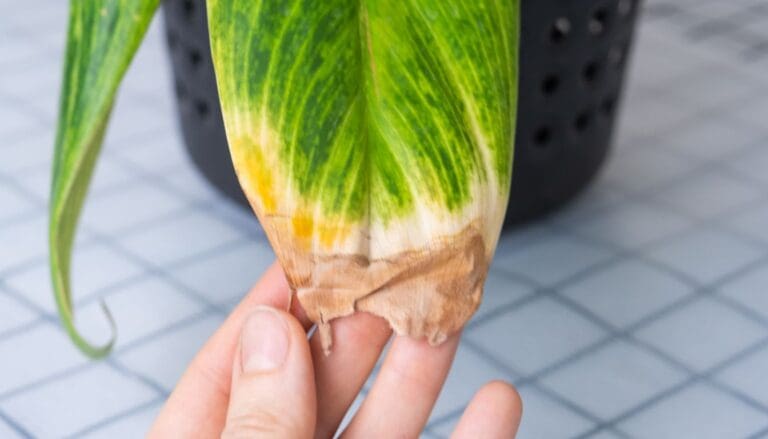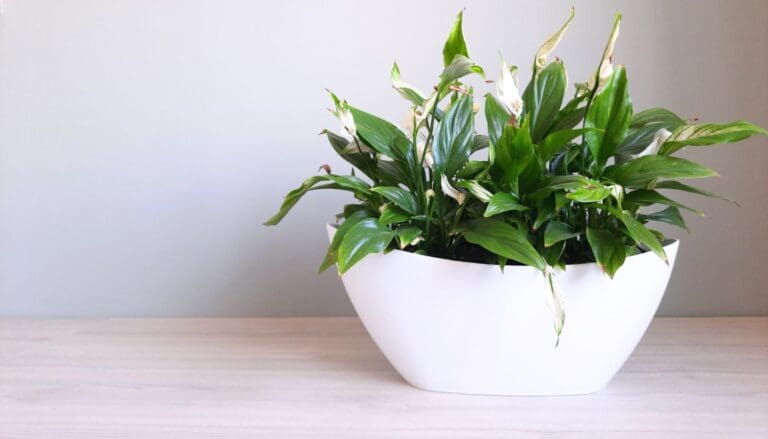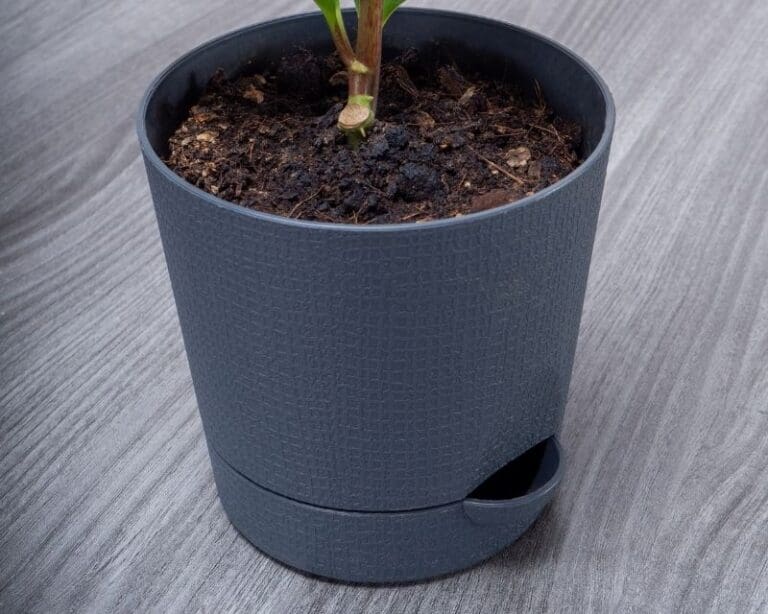9 Reasons Why Your Peace Lily Is Leaning To One Side!
The peace lily is a low-maintenance yet great air-purifying indoor plant. That’s why planters love to have it as a houseplant. Many people opt for peace lilies because these plants can survive in low light, but you might notice one problem that is your peace lily might be leaning to one side.
The most common reason behind a leaning peace lily plant is the lack of uniform lighting. If your peace lily doesn’t get even light distribution on all sides, it will lean to the side that receives the most light. Other causes include root-bound plants, lack of nutrients, and pest infestation.
You must keep your peace lily in a bright area that gets indirect sunlight and rotate it at regular intervals so that it gets light on all sides.
This article will explain all the possible reasons behind your peace lily leaning to one side and how you can fix each problem.
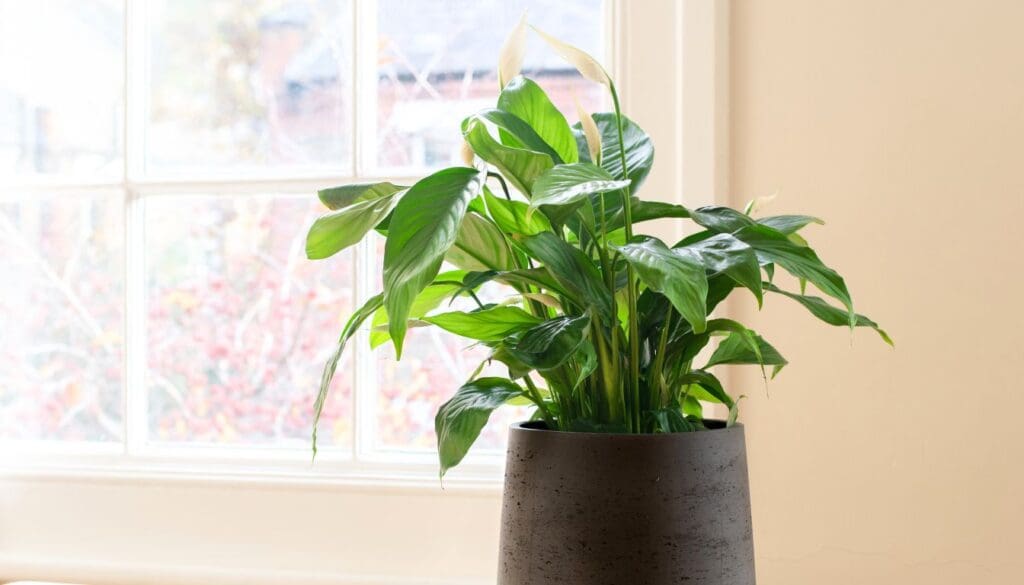
Please note: Simplify Plants is reader-supported. Some links in the post are affiliate links and I get a commission from purchases made through links in the post.
My Peace Lily is leaning
Outdoor plants get 360-degrees of sunlight. Hence their auxin levels are evenly distributed. But this is not the case with your beloved houseplant.
Auxin hormones are responsible for the well-regulated growth of plants.
Your peace lily can face trouble if you place it by a bright window and don’t rotate it for days. It will get all the light only on one side. It causes the plant to grow towards the light. This is known as phototropism.
Phototropism makes the plant looks lopsided and sad. To fix this, you just need to rotate your Peace lily.
A leaning peace lily may hint that it is exhausted, as all its energy goes in one direction. To avoid this, don’t forget to rotate your peace lily once a month to make sure that their auxin gets evenly distributed.
Inadequate lighting conditions
Peace Lilies can grow in partially shaded spots. It even does well in a low-light environment. That’s why you notice the Peace Lilies born naturally grow under the forest canopy where they never receive direct sunlight.
If exposed to prolonged direct sunlight, its leaves get burnt, dry out, and develop brown patches or tips.
Increased light and heat exposure are responsible for a higher transpiration rate, leading to more water loss. Due to this, the plant naturally leans to one side.
Never keep your Peace Lily thirsty for too long. Otherwise, it may lead to decolorization and withering of leaves.
Certain factors influence the frequency of water your peace lily needs. It will help you to keep your peace lily happy.
Also read: What Kind Of Light Does A Peace Lily Need? (Peace Lily Light Requirements)
Root-bound plant
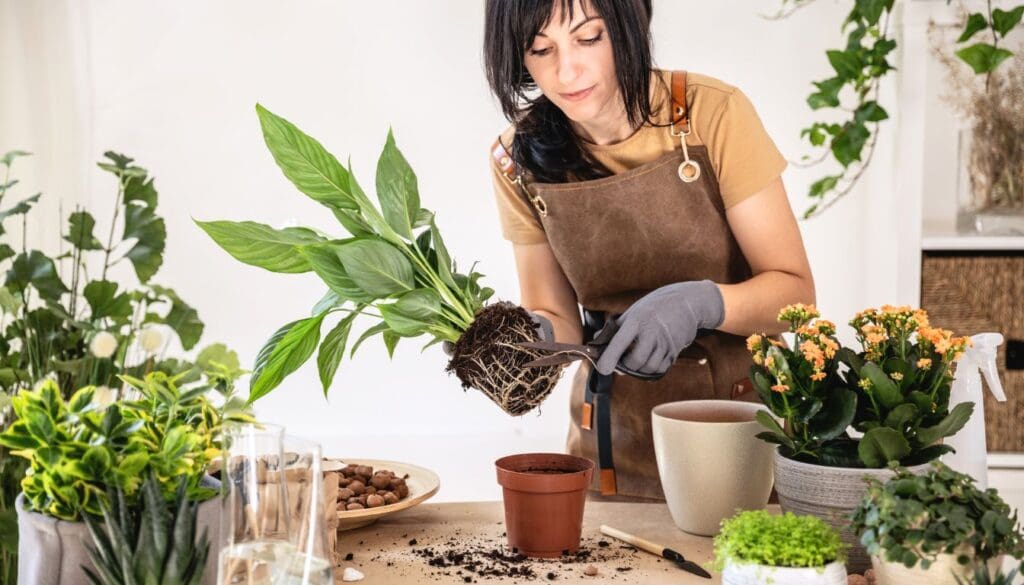
To keep your Peace Lily sound and healthy, keep checking the roots that support the entire health of the plant and repot the plant if the roots are not in good condition.
If the roots don’t get enough space to grow, the plant suffers from stunted growth. It then leans due to the lack of water and essential minerals and nutrients.
Also read: Do Peace Lilies Like To Be Root Bound? (+When To Repot)
Pest infestation
Peace Lilies rarely attract pests, but if they do, you might notice many problems in the plant, one of which is leaning.
Bugs like mealybugs, spider mites stick to the stem and leaves of a plant. They slowly consume the sap from the plant’s body and suck the life out of them. Eventually, the plant dehydrates and leans to one side.
Take a closer look at your leaning peace lily to check if any insects or bugs are at play.
If a sign of little fluffy tufts of white is found on your peace lily’s stems and leaves, you may have to deal with the case of Mealybugs.
The pest lives in colonies, so be ready to handle a mass of them.
Also read: Do Peace Lily Attract Bugs? (Identification+How ToGet Rid Of Them)
Temperature Variation
Peace Lilies prefer average indoor temperatures, most likely between 65-75°F.
It’s okay if the temperature drops by 10°F at night. But if the temperature difference is more than that, your Peace Lily will start leaning.
Low temperatures or sudden fluctuations will affect the health of your peace lily and cause stress, due to which it will lean to one side.
Inappropriate Soil
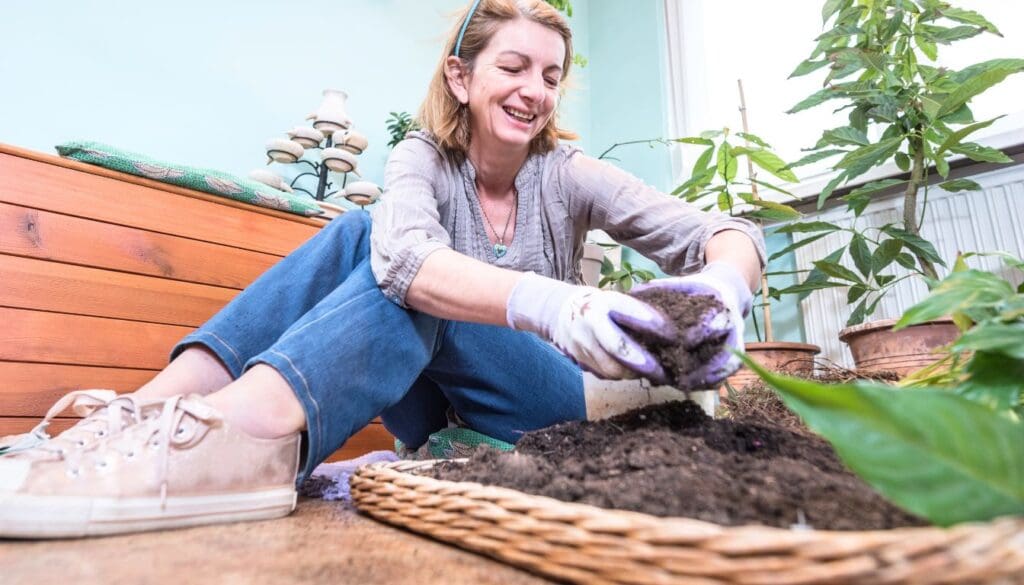
If the soil becomes waterlogged, root rot may occur, slowly leading to the demise of your peace lily. You should provide your peace lily an excellent growing medium that can drain water quickly.
Note: Peace Lilies do not prefer the following two kinds of soil:
- Clayey soil – This type of soil often leads to waterlogging or slow draining of water and is not ideal for the Peace Lily or any other houseplant.
- Sandy soil – This kind of soil drains too quickly, again not suitable for the peace lily. The reason behind this is it fails to provide sufficient time for absorbing nutrients and moisture.
Also read: What Kind Of Soil To Use For Peace Lily? (Peace Lily Soil Mix)
Inadequate Fertilization
Fertilization has immense importance on the proper growth of the plant. If it is not used in the right amount, the plant doesn’t get sufficient nutrients.
Your peace lily will get stressed because of a lack of essential nutrients. Then soil and roots bear the extra pressure to keep the plant healthy and upright.
Keep your plant’s food requirements in check. You will easily find if inadequate fertilizing is the culprit for your drooping plant.
Also read: What Kind Of Fertilizer Does A Peace Lily Need? (Peace Lily Fertilizer Ratio)
Insufficient Watering
Underwatering may cause your Peace Lily to lean on one side because the stem and leaves will not get sufficient water and nutrients from the roots. Consequently, the plant will dehydrate and become weak.
The only thing to do is be alert and water the peace lily before it becomes weak. But don’t worry as your peace lily is reasonably resilient and doesn’t succumb too easily.
You can miss watering your peace lily to some extent. If you find the leaves are leaning because of underwatering, give it some water. You will see your peace lily bouncing back quickly.
Leaving your plant thirsty for a long may backfire on you. It leads to the decolorization of the leaves. Leaves turn yellow, and natural moisture from it evaporates. So don’t keep your plant without water for too long. Otherwise, it will start leaning.
Understanding the factors that influence the frequency of watering your houseplants is a great skill to learn to keep your indoor plants happy.
Also read: How Often Should A Peace Lily Be Watered? (Peace Lily Water Requirements)
Overwatering

It is even more dangerous to overwater your peace lily because an overwatered plant is less forgiving than an underwatered one. You should take quick action if your peace lily is overwatered.
Overwatering a Peace Lily is the reason for waterlogged soil, due to which your plant may experience root rot. If root rot sets in, the central part of the plant ceases to work, and the plant dies.
The plant fails to consume water and nutrients from rotten roots. It can’t initiate the process of photosynthesis because of a lack of ingredients. The plant becomes weak, starts leaning, and shows other signs of root rot.
The yellow leaves of peace lily are a sign of overwatering. Take action the moment you see the decolorization of leaves of your plant.
So now it’s clear to you certain factors contribute to the drooping of your plant. Before you opt for any course of action or treatment, investigate each of them carefully.
How to fix a leaning Peace Lily?
You are now well acquainted with the reasons why your peace lily is leaning to one side. It’s time to fix those things and bring your peace lily back to a healthy state.
Here we will be discussing some steps you may apply to save your peace lily from leaning.
Fix the light.
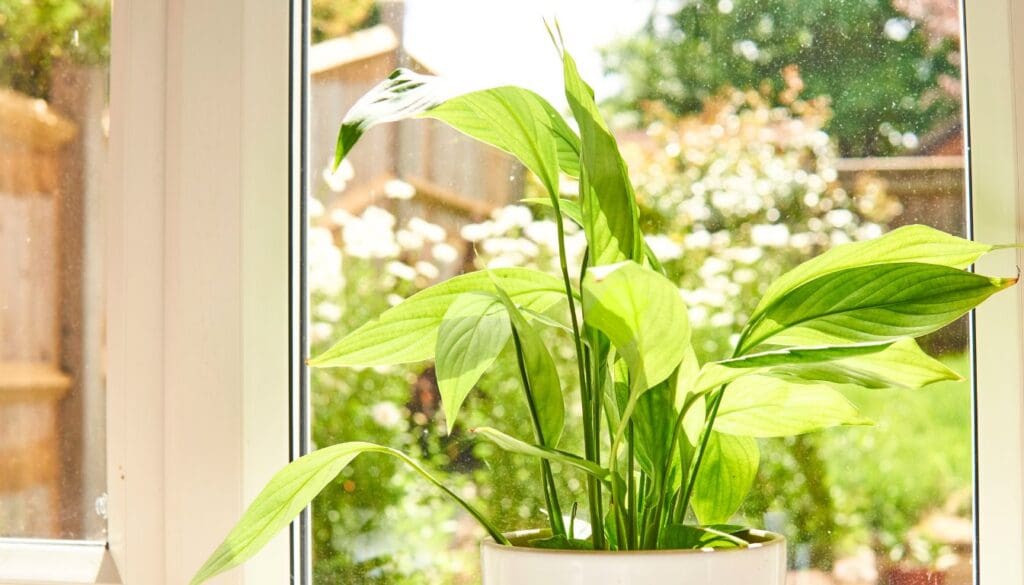
Sunlight plays an essential role in the sound health of the peace lily. Too much sunlight in the case of peace lily will damage its health.
We should take the following measures to avoid any issue from the sunlight on the plant.
- Keep your peace lily away from the window to avoid direct light.
- Choose a place that is neither too dark nor too bright. Choose a shady spot for your plant.
Water the plant right.
Get into a habit of watering the peace lily according to its needs. Watering it once a week might be enough. While watering, make sure that the root ball is getting enough moisture. You can buy a moisture meter to check it.
If you shift the plant to a new container, ensure the plant’s roots can gather moisture from the new soil.
Do not let your peace lily sit on standing water as that will create an unhealthy environment, making the plan weak and vulnerable to pest attacks and fungal infections.
Do not let your peace lily be thirsty either. You can follow a watering routine but make sure to water after checking the soil.
Good watering practice resolves many issues and takes care of your peace lily.
Repotting your peace lily.

If you suspect that the soil type is responsible for the leaning of the peace lily, you may opt for repotting your plant in fresh, more suitable soil.
Choose a porous container for your peace lily. To enjoy your plant’s best growth, use a mix of perlite, peat moss, and fine bark as the fresh soil.
Tips to consider while repotting: The best thing you can do is keep your potted Peace Lily inside a larger container. Then fill up the space between the two pots with Sphagnum moss. This moss will increase the humidity around the plant.
You can also use a treatment of vitamin B1 to help the root development of the plant.
Avoid temperature fluctuations.
- Avoid keeping your peace lily near the heater or fireplace. It can cause temperature fluctuations, and the plant may suffer from unusual heat and temperature differences.
- Keep the peace lily out of Air Conditioners’ direct line of air gusts. The same goes for the fans. Quick circulation of air can cause temperature fluctuations.
Use adequate fertilizer and pesticides.

70% isopropyl alcohol is one excellent remedy to fix mealybug’s attacks on your plant. Pour the solution in a handy spray bottle and get rid of all the bugs. Spray the solution thoroughly on the foliage. It will make sure the plant’s quick recovery.
After the treatment:
- Put your Peace Lily in the bath.
- Gently rub the plant’s body with cool water to rinse off the dead bugs.
- If the bugs remain, use a cotton swab or cloth soaked in rubbing alcohol to remove the bug.
You can use a dilute solution of dish soap as an alternative to using rubbing alcohol. Use 1 tsp of dish soap and mix it with 1 liter of water. Jerk well and pour into a spray bottle. Spray the solution such that the entire plant is covered.
How do I keep my peace lily upright?

If you want to clip your plant, choose early summer to do so.
Pruning at this time helps the plant to recover quickly and grow better. You can use a stake to keep your peace lily uptight too.
1. Prune a few portions of the plant.
Before pruning your peace lily, observe the plant thoroughly. If you see any sign of a new extension on the plant, that’s good for it.
Now to accelerate its new growth, prune some portions of the plant. Clip before the leaf joint or a closer area of the main stem with sterilized scissors.
If the peace lily is growing from the tip, cut the top part of the plant to support its growth.
2. Support the plant using stakes.
Stakes are used to keep plants upright so they don’t lean and keep growing in a particular direction.
If you decide to use a stake, place it in the soil within an inch or two from the base of the plant. Use tape to stick the stake to the stem.
You can go for any stake, whether wooden, bamboo, plastic stakes, etc.
If a single stake can’t give enough support to keep your plant upright, use multiple ones to do the same.
Final words
Do not panic if your peace lily starts leaning to one side. It is a concern but not something you cannot fix. If you identify the problem, you can make your peace lily upright again.
Fertilize the plant well if it is not getting enough nutrients, do not overwater or keep it thirsty for too long.
Rotate it at least once a month to distribute the light on all sides of the plants evenly. Repot your peace lily if it gets root-bound and keep pests away to stop the leaning of the plant.
Until your peace lily becomes healthy and finds a balance, use a stake to hold the plant upright and prune some parts to reduce the plant’s stress.
Ref: ScienceDirect, NCBI, University of Vermont, Nationalgeographic, NC state university, University of Florida, The University of Arkansas, Queensland Government.
Recommended Garden Supplies
| Product Image | Our Recommended Gardening Supplies | Check Offers! |
|---|---|---|
Top Top
Top
Top
Top
Top
Top
Top
Top | rePotme Houseplant and Tropical Classic Potting Soil Mix | Check Offer On Amazon |
 Top
Top
Top
Top
Top
Top
Top
Top | Espoma Organic Indoor Plant Food | Check Offer On Amazon |
 Top
Top
Top
Top
Top
Top
Top
Top | GooingTop LED Grow Light 6000K Full Spectrum Clip Plant Growing Lamp | Check Offer On Amazon |
 Top
Top
Top
Top
Top
Top
Top
Top | Soil Moisture Meter | Check Offer On Amazon |
 Top
Top
Top
Top
Top
Top
Top
Top | Govee Hygrometer Thermometer, Bluetooth Enabled! | Check Offer On Amazon |
 Top
Top | LEVOIT Humidifiers for Large Room(Best For Plants) | Check Offer On Amazon |
 Top
Top
Top
Top
Top
Top
Top
Top | Upgraded DIY Automatic Drip Irrigation Kit, 15 Potted Houseplants Support | Check Offer On Amazon |
 Top
Top
Top
Top
Top
Top
Top
Top | Stainless Steel Heavy Duty Gardening Tool Set | Check Offer On Amazon |
 Top
Top
Top
Top
Top
Top
Top
Top | Bonide Insecticidal Soap | Check Offer On Amazon |
 Top
Top
Top
Top
Top
Top
Top
Top | Bonide 32 oz Spray Neem Oil for Organic Gardening | Check Offer On Amazon |
 Top
Top
Top
Top
Top
Top
Top
Top | Garden Safe Fungicide | Check Offer On Amazon |

